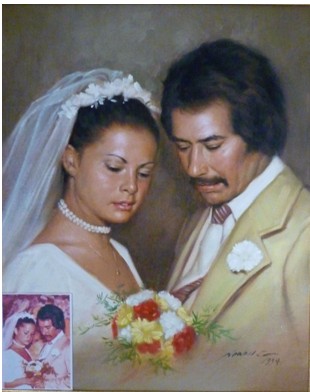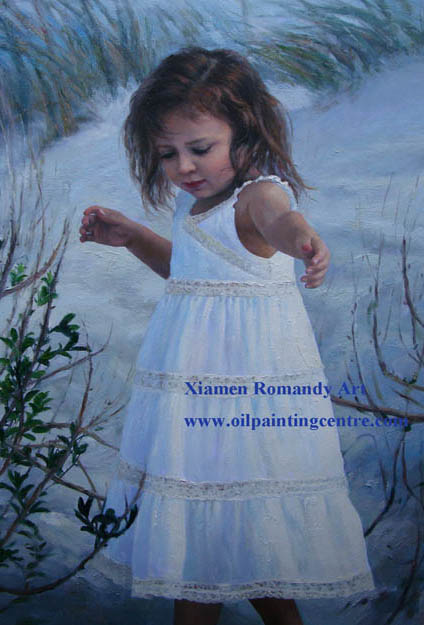Oil Painting Portrait Techniques-22 Helpful Tips:
1. Try theses warm-up exercises:
• Paint with only one color. Develop a sketch with only one tube color and water. It will help you develop an instinc- tive sense of how much water is needed to achieve various degrees of transpar- ency and opacity. This exercise should be done without drawing first. Another goal is to connect shadow shapes.
• Paint color shapes without drawing them first. Although drawing is important to watercolor painting, you don’t want painting to become a process of filling in care- fully-drawn shapes. On the contrary, you want the painted shapes to have their own beauty and harmony.
2. Make blind-contour and quick-gesture drawings to loosen up. To make a blind contour drawing, keep your eyes focused on the subject, not on the drawing. Never lift the pencil from the paper, and don’t look at the drawing until it is complete. The resulting drawing may look very bizarre and completely disjointed, but you’ll recognize that you learned a lot by keeping your attention on the move- ment of lines across the body of the person you are drawing.
Gesture drawings are made quickly and are intended to capture the sense of weight distribution, movement, and overall proportions. They may wind up looking like a bunch of overlapping scribbles to someone else, but you’ll find they will help you become more responsive to the action of the figure. One of the best books on this subject is The Natural Way to Draw by Kimon Nicolaides (Houghton Mifflin Company, Boston), which explains how to make both types of drawings. The classic draw- ing book also explains how the recom- mended exercises can help you loosen up and become more sensitive to subtle shifts in lines, directional movements, weight distribution, and expression.
3. Make quick watercolor sketches from life or photographs, and let them guide the development of your final painting. Watch your paper, and don’t rely on copying your photo or subject. This process will help you avoid becoming too tight and concerned about small details. Do a minimum amount of drawing, and get right to the painting process. Another way of using drawing as a means, not an end in itself, is to do a minimal amount of drawing to place the subject within the rectangular space of the paper and guide your brush through the initial stages of painting. Try a few exercises in which you make the briefest graphite lines possible and then jump right into the painting process.
4. Arrange color mixtures in separate palettes with the cool combinations separated from the warm ones. You’ll want to have thick puddles of pigment on the palette that are similar to those an oil painter would mix. Make sure those “pigment puddles,” as I call them, don’t flow togeth- er and create dull, dirty combinations. Just keep families of colors together and you won’t have to worry about what pigment combinations wind up on your brush.
5. Starting with dry paper, load a large round or flat brush with pigment and water, and react to your subject. Always use the biggest brush you can handle to avoid tightening up and mak- ing lots of short strokes on the paper.
6. Don’t hold the paint brush as you would a pencil. Grip it so that you have to move your entire arm in order to control the flow of paint.
7. Control values with the amount of water you mix with the paint. One of the exercises (making color swatches) is designed to help you develop an instinctive sense of how much water to mix with the pigment. If you don’t yet have that subconscious knowledge, test out your mixtures on the same kind of paper on which you are developing the painting. With this exercise you will also discover how not to overwhelm one color and how to dis- cover others.
8. Clean your brushes before reloading them with completely different color combinations.
You want to develop the habit of wash- ing out your brush and drying it with a paper towel after you finish painting an area. That habit will help you avoid making the mistake of picking up an unwanted color or a mixture that is much too intense.
9. Try to get the values close to your final version right away instead of building up layers. You can always return to darken your shapes further after they dry.
10. Keep the painting simple. Don’t try to say too much. You don’t have to explain everything about the subject to viewers. Let them use their imagination.
11. Close one eye when you look at the painting so that you only see the general shapes, not the details, and don’t forget to squint to see the values more easily.
12. Test background colors on the painting and not on separate sheets. Colors and values have a relative influence on a painting, and the only way to gauge whether or not you have the right mixture is to put it down on the painting. You can always adjust while the paper is wet by lifting paint off or adding different pigments.
13. Look for the personal con - nections you have with the image —something that grabs you—such as the glance in a person’s eyes;
14. Let the medium of water - color connect with the subject in an expressive way. That is,use wet-in-wet, dry brush, thrown, or tight applications of paint where they are most indicative of the way you feel about the subject. (Oil Painting Portrait Techniques-22 Helpful Tips)
15. Let the color flow onto the paper, changing the pigment combinations until you recog - nize the effect you want. That is, start with one dominant color, and then immediately load other colors on your brush or drop them into the wet areas of the paper. The variety will help create a sense of dimension, changing light, and richness that will enhance the painting.
16. Don’t be afraid to throw the paint onto the paper to make other random, quick gestures.
17. Avoid painting into wet areas because that might turn the color muddy.
18. Look for special shapes and unusual colors that appear.
Remember, a painting has a life of its own and isn’t just a rendering of what appears in the photograph or the live model. The shapes you paint should be beautiful, integrated, and varied.
19. As you work, make sure to connect the painted shapes to one another as well as to the white shapes of unpainted paper. This is one of those “rules” of good composition because it is a way of directing the viewer ’s attention from one part of a painting to another.
20. Resolve problems imme - diately by looking for natural paths, but don’t lose your sense of the entire painting.
This is a tough balancing act for every painter. You want to resolve problems, but you don’t want to overwork an area.
21. Finish your paintings by marking the darkest darks —the corners of the mouth, the nostrils, the eye lids, the shadow under the chin, etc.
22. Make painting an exciting, spontaneous, fun adventure,and you’ll never be disappointed with the results.
Edited by Kevin from Xiamen Romandy Art Limited.
(Xiamen Romandy Art is a professional oil paintings supplier from China. If you want to convert your photos into high quality oil paintings, or you want the masterpiece oil painting reproductions, please don's hesitate to contact with us.)
Romandy Art Website: http://www.oilpaintingcentre.com
Tags: Oil Painting Portrait Techniques-22 Helpful Tips, Portrait Painting Techniques.
|